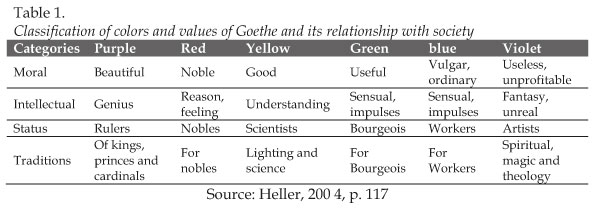
doi.org/10.15178/va.2018.141.51-77
RESEARCH
COMPARATIVE ANALYSIS OF CHROMATIC SYMBOLOGY IN ADVERTISING. NIKE IN CHINA AND SPAIN
ANÁLISIS COMPARATIVO DE LA SIMBOLOGÍA CROMÁTICA EN PUBLICIDAD. NIKE EN CHINA Y ESPAÑA
ANALISES COMPARATIVA DA SIMBOLOGÍA CROMÁTICA EM PUBLICIDADE. NIKE NA CHINA E NA ESPANHA
Carmen Llorente Barroso1 Bachelor of Audiovisual Communication and PhD in Advertising and Audiovisual Communication from the UCM. Her doctoral thesis won the 2009- 2010 Extraordinary Doctoral Award of the UCM. Accredited as university professor by ANECA University, she teaches courses at UCM. She is an active member of CSO2015-66746-R, S2015 / HUM-3434 (PROVULDIG-CM), R14, CEU-CITEC and ASOCREA, an association in which she held the position of Secretary General until 29 /10/2011 to 4 / 02/ 2017. Author of multiple scientific-academic publications and participant in national and international conferences, she has been a guest lecturer at the University of Berkeley, CA, USA. Her research interests focus on the study of strategic and creative keys to ensure effective communication. Orcid ID: orcid.org/0000-0001-7710-0956. Reseach Gate: https://www.researchgate.net/profile/Carmen_Barroso3. Google Scholar: https://scholar.google.com/citations?user=jdsAFJYAAAAJ. ResearcherID: B-8062-2015. Scopus Author ID: 55652402000
Francisco García García1 Doctor of Information Sciences. Professor of Audiovisual Communication and Advertising at the Faculty of Information Sciences of the Complutense University of Madrid (UCM) since 1995. He is a professor of Audiovisual Narrative, Audiovisual Rhetoric, Methods of Creativity and History of Audiovisual Media. In addition, he has directed the PhD Program Techniques and Processes for Image Creation (UCM). In the field of research, he is director of the Research Group SOCMEDIA of the UCM and editor of the Scientific Indexed Journal Icon 14. In addition, he is director of the National Center for Educational Information and Communication of the Ministry of Education, Culture and Sport of Spain. He has been Senior Researcher in several research projects of the Ministry of Innovation and Science of Spain. The last OPEN DATA CITIZEN. Orcid ID: orcid.org/0000-0001-5394-4804. Reseach Gate: https://www.researchgate.net/profile/Francisco_Garcia43. Google Scholar: https://scholar.google.es/citations?user=as2gqFUAAAAJ&hl=es. Academia.edu: ucm.academia.edu/FranciscoGarcíaGarcía. Scopus Author ID: 55439107500
Virginia Soria Jiménez2 Bachelor of Advertising and Public Relations and Audiovisual Communication from the University CEU San Pablo of Madrid. She has also participated as a speaker at the Sixth International Congress on Innovation and Creativity at the Complutense University of Madrid (UCM) and the Second Conference on Introduction to Advertising Research and Institutional Communication of the University CEU San Pablo. Her research expertise focuses on the socio-psychological study of color in advertising, a topic on which her Final Graduate Project focuses, for which she obtained the qualification Graduate of Honor. In April 2013 she won San Isidoro de Sevilla First Prize of Introduction to Scientific Research and Academic Excellence in recognition of her work on the chromatic adaptations of graphic advertising to the socio-cultural context. In her career, she has worked for agencies such as Starcom, JWT or Barlovento Communication among others.
1Complutense University of Madrid. Spain
2CEU San Pablo University. Spain
ABSTRACT
The different perceptions of color according to each socio-cultural context constitute a matter of relevant interest from the point of view of advertising creativity: black & white, for example, means mourn in different cultures and therefore must be used with care in international advertising. Color red is important to catch the western audience eye… but in China it is also perceived as a lucky color, which is by itself a powerful claim for potential customers. Therefore, this piece of research has analyzed the creative possibilities that can derive from the symbolic and cultural connotations of colors. To this end, a comparative analysis has been proposed in the design of which different theories on the perceptions of color have been considered in two very different cultures: European and Asian. This model has been used to analyze a sample of Nike graphic campaigns in order to obtain results that allow us to corroborate, through this case, that large brands use chromatic symbology in the design of their graphic campaigns in order to expand their possibilities of communicative effectiveness.
KEYWORDS: Color, Nike, Advertising, Chromatic Connotations, Symbology
RESUMEN
Las diversas percepciones del color según cada contexto socio-cultural constituyen una cuestión de relevante interés desde el punto de vista de la creatividad publicitaria: el negro y el blanco son, por ejemplo, colores opuestos que significan luto en diferentes culturas, y que por tanto deben ser empleados con mucho cuidado a la hora de internacionalizar una campaña de Marketing. El color rojo es muy importante para llamar la atención del público occidental… pero en China es además signo de buena suerte. Lo que en sí mismo es un poderoso atractivo para muchos potenciales compradores. Por ello, en esta investigación se han analizado las posibilidades creativas que pueden derivarse de las connotaciones simbólicas y culturales de los colores. Para ello se ha propuesto un análisis comparativo en cuyo diseño se han considerado distintas teorías sobre las percepciones del color en dos culturas muy dispares: la europea y la asiática. Dicho modelo se ha empleado para analizar una muestra de campañas gráficas de Nike con el fin de obtener resultados que permitan corroborar, a través de este caso, que las grandes marcas utilizan la simbología cromática en el diseño de sus campañas gráficas con el fin de ampliar sus posibilidades de eficacia comunicativa.
PALABRAS CLAVE: Color, Nike, Publicidad, Connotaciones Cromáticas, Simbología
RESUME
As diversas percepções das cores segundo cada contexto sócio cultural constituem uma questão de relevante interesse desde o ponto de vista da criatividade publicitária. Por isso, esta investigação foi analisada as possibilidades criativas que podem derivar-se das conotações simbólicas e culturais das cores. Para isso propuseram uma analises comparativa em cujo desenho foi considerado distintas teorias sobre as percepções das cores em duas culturas bem diferentes: a europeia e a asiática. Este modelo foi empregado para analisar uma mostra de campanhas gráficas da Nike com a finalidade de obter resultados que permitam confirmar, através deste caso, que as grandes marcas utilizam a simbologia cromática no desenho de suas campanhas gráficas com a finalidade de ampliar suas possibilidades de eficácia comunicativa.
PALAVRAS CHAVE: Cor, Nike, Publicidade, Conotações Cromáticas, Simbologia
Received: 10/10/2017
Accepted: 28/11/2017
Published: 15/03/2018
Correspondence: Carmen Llorente Barroso. carmenllorente@ucm.es
Francisco García García. fghenche@gmail.com
Virginia Soria Jiménez. virsoria@gmail.com
1. INTRODUCTION
Colors are an active part of our environment and the connotations associated with them are used by experts in different persuasive communication modalities. In relation to this consideration, Lee and Barnes Jr. (1990, p.25) declared: “Color shapes human perceptions of the world in which we live. Color gives us different impressions of objects that we see.”
A color alone or by combining with other colors can assume a symbolic meaning and evoke different emotions (Wong, 1995, p.149). These meanings respond to the psychological effects of colors and different cultural traditions (Heller, 200 4, p.48). Myths, taboos and customs intervene in the chromatic associations that develop within each context. Therefore, it should be taken into account that color is a factor influenced by both natural phenomena (Ko, 201 1, p.871) and contextual variables.
The chromatic tradition of different cultures is very long-lived. As languages developed, colors were being defined following, in most places, the same order (Berlin & Kay, 199 1, p.5). Thus, white and black were defined in order to differentiate day from night, and then red, green, yellow, blue, brown, purple, pink, orange and gray were established (Edwards, 200 6, p 156). However, red is considered the first color, properly speaking, the reason why “colored” is “red” (Heller, 200 4, p.53). Since its birth and over the years, colors have been welcoming a symbolic dimension fruit of the emotional effects that occur when entering into relationship with them (Edwards, 200 6, p.157). In this sense, Harald Küppers (1982, 21) considers that color only exists as a sensory impression of the observer, something that Goethe already pointed out in 1810 when observing the moral effects of color:
[color] [...] produces on the human soul individually a specific effect and, in combination, an already harmonious or characteristic effect, often also not harmonious, but always defined and significant that is closely linked to the moral sphere (Goethe, 192 2, p.203).
Brands have always based their own construction on communication based on the symbology of shapes and colors. Thus Nike swoosh (corporate brand emblem) has been exalted as a symbol of victory, challenge and overcoming (Garcia Garcia & Garcia Guardia Llorente Barroso, 2010, p. 139), using formal, symbolic and implicit metaphors with a high degree of abstraction (Llorente Barroso & García García, 2015 a , p.489). The significance of this symbol responds, to a large extent, to the connotations that emanate from its predominant presence in black to represent the sports brand. In this chromaticism lies the simplicity and functionality (Heller, 2004, pp. 140-149) of its corporate logo.
In advertising communication, there are variables (such as sex or race) that determine a chromatic preference, to a large extent, responsible for the effectiveness of messages (Lee & Barnes Jr., 1990, p.26).
The study this article presents seeks to deepen the chromatic analysis of advertising graphics, covering the different treatments of color made by the same brand in graphic advertising that develops in two very different contexts. Specifically, we analyze the associations of colors to different socio-cultural features that determine the use of different chromatic parameters in graphic campaigns according to the specific context in which they are launched. This study has focused on Spain and China, countries selected for manifesting markedly contrasting political, cultural and demographic characteristics.
2. OBJECTIVE AND HYPOTHESIS
The main objective of this piece of research is to study the influence of socio-cultural and psychological factors on the use of colors in graphic advertising that the same international brand generates for different contexts.
The hypothesis that arises is that brands use colors discriminately in their graphic campaigns to adapt them to the connotative code of each socio-cultural context in order to achieve the most effective communication of the message in each case.
On the other hand, the need to specify some concepts for the correct development of this piece of research requires the prior realization of a study of the state of the art.
3. THEORETICAL FRAMEWORK
3.1. Main European theories
In the definition of colors, there are traditionally two fundamental chromatic systems: one that deals with their light properties and another that does it with their pigmented characteristics.
The RGB system (Red, Green, Blue), additive synthesis or three-color process is a discovery of Newton, who in the seventeenth century achieved the decomposition of sunlight through a prism of glass in a range of wavelengths (1) (Zelanski & Fisher, 200 1, p.13). This spectrum collected the colors violet, indigo, blue, green, yellow, orange and red (Edwards, 200 6, p.15) that make up the chromatic circle of light colors (Caivano, 199 5, p.13). The RGB system considers that light has a corpuscular nature (Beléndez, 200 8, p.13) and makes it possible to recreate the white light by
(1) The wavelength is the distance between crests of a wave energy. They are expressed in nanometers (nm.) and are visible to the human eye from 350 nm. and up to 750 nm. (period covering primary colors) (Zelansky & Fisher, 200 1, p. 13) or 380 nm. and to 780 mn. (Sanz & Gallego, 200 1, p. 366).
Adding three colored lights: green, blue-violet and red-orange. These three lights are the only ones that cannot be obtained by mixing others (Carreres Ribera, 201 1, p.20) and, if they combine, they can give rise to all the colors that the human eye can differentiate, that is why they are also primary colors (Drew & Meyer, 200 8, p 55). The colors originating from the sum of two primaries (yellow, cyan and magenta) are known as secondary ( Zelansky & Fisher, 200 1, pp. 13-16). This system is used in the reproduction of colors in digital systems (Ambrose & Harris, 200 5, p.35), which are in accordance with their light properties.
The CMYK system (Cyan, Magenta, Yellow, Key), subtractive synthesis or four-color process refers to the pigment colors (Gatter, 200 5, page 39). The development of this system was necessary to solve the graphic needs and enable the reproduction of color images by adding inks (Ambrose & Harris, 200 6, pp. 32-33). The CMYK system consists of four basic colors: first, cyan, magenta, yellow, which are the only pigments which cannot be obtained by mixing others, and, on the other hand, black (key) (2), which cannot be achieved after modifications either, which is why it was included as a base pigment (Gatter, 200 5, p 42). The four-color process translates the chromatic information composed of lights (RGB), so that the primary lights match the secondary pigment colors and the basic pigment colors match the secondary lights (Carreres Ribera, 201 1, p.22). This system is based on some of Goethe’s findings who, unlike Newton, based his theory on qualitative methods. Newton considered colors to be achromatic light rays (Goethe, 200 2, p. 50), however, Goethe developed a theory based on the study of nature and its different forms of representation (Goethe, 200 2, p. 13). His great contributions to the study of color have been: the consideration of the symbolic meanings that each color can have (Ferrer, 199 9, p.82) and its classification according to the moral, intellectual characteristics, status and traditions of each context (Heller, 200 4, p.127, Table 1). The practical disadvantage of Goethe’s contribution is that he did not conceive the mixtures, so he did not differentiate the behavior of the combinations among pigments -more colors, darker mixture- from the combinations among lights -more colors, clearer mixture- (Heller, 200 4, pp. 282-283).
(2) Black is represented by the letter K referring to the real meaning of this color in the CMYK process, key -key, key- (Gatter, 2005, p. 33).

3.2. Main Asian theories
Among the main Asian theories that have served to explain the meaning of colors, two stand out: that of Feng Shui and that of Yin and Yang.
Feng Shui (3) is a philosophy that aims to create harmonious environments, capable of generating an intimate and fluid relationship between man and his environment and attracting health and abundance (Álvarez, 200 8, p.121). It relies on the observation of nature, the influence of traditions (Tibet, Hindu-Buddhist, Confucian and modern cultures) and knowledge from Buddhism, the Tao, the Book of Mutations or I-Ching and of Chinese Astrology (Álvarez, 200 7, page 18). From the Taoist philosophy, it takes the consideration that there are five elements among which there is a circulation of energy that represents the entire environment and manifests the following chromatic links (Skilton, 200 5, pp. 29-32):
(3) Feng Shui means “air-water” (Alvarez, 200 7, p. 17).
a) The fire element can be a reflection of aggressiveness and conflict if there is an excess of said element, or it can symbolize emotional coldness if the opposite occurs. It is located in all variants of red color.
b) The earth element can create a dense and conservative environment, or otherwise, disorder and instability. It is found in yellow and earthy colors.
c) The wood element gives values such as responsibility and burden, or in its opposite effect, lack of creativity and irresponsibility. It is found in plant colors.
d) The metal element generates obstinacy or confusion. Chromatically it is found in gray, white, silver and gold.
e) The water element, as a flowing element, symbolizes dispersion and lack of it, rivalry, pettiness or anxiety. It is found in black or dark blue.
In relation to these associations, a part of Feng Shui deals with the importance of the use of colors to reach equilibrium with the environment, linking each color with a daily activity (Table 2):
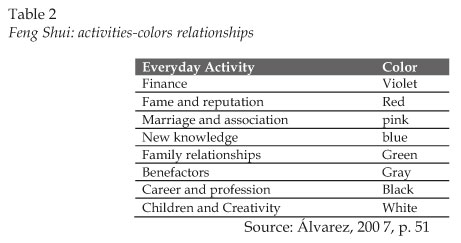
Yin and Yang is the Chinese philosophy that explains the world as the combination of two opposite-complementary. Yin and Yang represent different energies that seek a balanced balance in a continuous movement and the existence of one is impossible without the other (Skilton, 200 5, p.12). They are “vital breaths” that govern the destiny of the world, Yin as receptive softness and Yang as an active force (Chen, 200 8, p 68, 86). Yin is representative of the negative or the feminine, while the positive or masculine takes its form in Yang. Yin appears associated with the Moon, the cold, the white color, emptiness, passivity, wetness, the night, the left side and everything soft (Skilton, 200 5, pp. 12-13). Yang represents the Sun, the heat, the black color, fullness, activity, dryness, the day, the right side and hardness (Skilton, 200 5, pp. 12-13). The graphic symbol of Yin and Yang , known as Tai Chi , is made up of the colors white with a black point (Yang) and black with a white point (Yin), linked (Skilton, 200 5, p.13 ); the points that are born in each part represent the embryos of the opposite (Skilton, 200 5, p.14). This sign reflects that, to Asians, nothing is absolutely black or rigorously white due to the interrelation they consider to exist among all the elements that make up the context (Ferrer, 199 9, p.34). This influence also extends to the composition of colors, since nothing can exist without its opposite-complementary. Black and white (4) have the same importance; in opposition to other cultures, in Asia, white and black are considered both feminine and one does not entail the opposite of the other (Heller, 200 4, p.98). White includes the symbology of death and black the symbol of the beginning or birth (Heller, 200 4, p.98). The most important color in China is yellow, considered the male pigment par excellence, but so are red and green (5) . Black, white and soft colors fall within the female group (Heller, 200 4, p.98).
(4) The chromaticity connotations associated with Yin and Yang are unclear; while Skilton (200 5, p. 12-13) makes an association by opposite chromatic categories, Heller (200 4, p. 98) makes an interpretation of black-white matrix as energy stream representing the Yin and Yang set.
(5) Blue is not considered a basic color in the Oriental country, but a variety of green (Heller, 200 4, p. 98).
3.3. Color and advertising
Labrecque, Patrick and Milne (2013), considering the chromatic meanings and their ability to influence thoughts, feelings and behaviors of consumers, address their importance from the field of marketing. Referring to the complexity of their nature, they determine that “culture influences learned color associations” (Labrecque, Patrick & Milne, 201 3, page 194). Under this consideration, they study the cultural influence on the chromatic associations we learn and which are responsible for the diverse perceptions we develop when evaluating the objects having them.
In the relationship between culture and chromatic associations, two fundamental considerations that have led to various possibilities in the study of color and advertising have developed (Labrecque, Patrick & Milne, 201 3, p 194;.. Gorn, Chattopadhyay, Yi & Dahl, 199 7, p.1398):
1. A trend that determines significant differences in the chromatic association according to each culture. Within this current are Block and Kramer (2009) and Madden, Hewett and Roth (2000).
2. Another trend that considers the existence of chromatic meanings shared in all cultures, this trend being shared by authors such as D’Andrade and Egan (1974) or Fraser and Banks (2004).
At the same time, Labrecque, Patrick and Milne (201 3, p.194) estimate that certain cultural meanings attributed to colors may change over time. In this sense, they refer to two examples; the first, related to the minimization of the negative connotations attributed to the yellow - color used by the Nazis to identify the Jewish people - by the Jews over the years (Kreitler & Kreitler, 1972); the second, related to the influence of globalization and the Western culture on certain Oriental chromatic traditions; thus, Chinese brides have changed their red dress into white (Baker, 2009).
Referring to the specific field of advertising, Labrecque, Patrick and Milne (201 3, pp. 195-196) highlight two fundamental points of interest:
1. The importance of color as compared to black and white advertising. Color manifests itself as a sign of quality and efficiency, acting as an exhortative resource – it motivates consumers and captures their attention - and mnemonic – it facilitates the memory of the message.
2. The influence of each color on consumers. Color influences one’s mood and the evaluations of products. In this regard, Gorn, Chattopadhyay, Yi and Dahl (1997, pp. 1397-1398) determined that the highest levels of chroma (6) and value (7) influence the feelings of emotion and relaxation, respectively, being able to generate a more favorable attitude towards advertising and towards the brand.
(6) “Chroma refers to saturation; highly saturated colors have a greater proportion of the pigment in them” (Gorn, Chattopadhyay, Yi & Dahl, 1997, p. 1387).
(7) “Value is the degree of darkness or lightness of the color relative to a neutral scale that extends from pure black to pure white” (Gorn, Chattopadhyay, Yi & Dahl, 1997, p. 1387).
Color becomes a key element making it possible to build and strengthen the relationship between consumers and brands, being part of the corporate “DNA” (Labrecque, Patrick & Milne, 201 3, page 199). In this line, Lee and Barnes Jr. (1990) develop a study of ads in magazines, considering the psychological effects colors have on the emotions of human beings and in order to improve advertising effectiveness. These authors perceived that advertising professionals did not use color to improve the response of their target to their messages according to their sex, but they saw a discriminated use in advertising messages aimed at different races (Lee & Barnes Jr., 199 0, p 29).
4. METHODOLOGY
So as to achieve the objectives and corroborate the hypothesis, a methodology based on the comparative analysis of a sample of graphic creativities of Nike brand for China and Spain has been proposed. For the development of this study, we decided to choose Nike as an example, as it is an international brand that performs graphic advertising actions of considerable notoriety in the two selected countries, accumulating a great socio-cultural impact at the international level. Such impact is reflected in the American lifestyle, which is why it was incorporated into the American Marketing Association’s Hall of Fame in 1991, cataloging it as an icon of the country (Goldman & Papson, 1998, page 18). In fact, in the 1990s, Nike rose as one of the most recognized brands in the world and an international symbol of athletics (Spar, 2003). To a large extent, this recognition comes from the great communication strategies of the brand and its recurrent relationship with significant cultural symbols (Goldman & Papson, 1998) that have transferred to the brand their values and the admiration the public has for them (Llorente Barroso Garcia & Garcia, 2015, pp. 478-479).
The creativities that make up the sample have been selected because they match the criterion of importance in the use of a certain color in each of the respective countries in which our research is focused. Mentioned importance has been calculated based on two parameters that have allowed a selection of pieces:
a) The approximate extension of the color in the graph.
b) The importance of the colored object according to the position it occupies in it and / or its lighting.
The analysis of each graphic piece has been divided into two major categories of study:
a) The chromatic expression, which has been examined from the chromatic systems RGB (light) and CMYK (pigment).
b) The chromatic content of the piece, taking the denotative meaning and especially the connotative (symbolic) meaning of each color as the main elements for analysis.
The comparative analysis has been carried out using an analytical record model (Figure 1) that has been applied systematically to the creativities of the sample, which has allowed an orderly compilation of results, in compliance with the level of objectivity required by research to extract valuable results
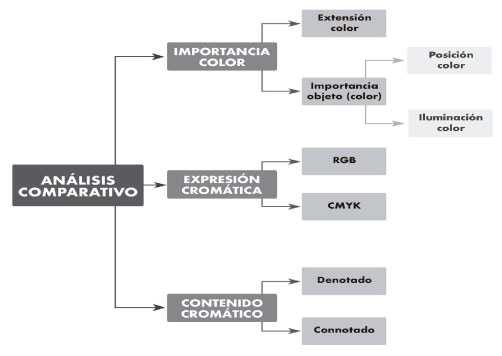
5. RESULTS OF THE COMPARATIVE ANALYSIS OF THE INFLUENCE OF CHROMATIC ASSOCIATIONS ON GRAPHIC ADVERTISING IN CHINA AND SPAIN
To facilitate the understanding of the results, they have been recorded in tables that allow the comparative analysis to be visualized.
5.1. Comparative analysis of the use of blue
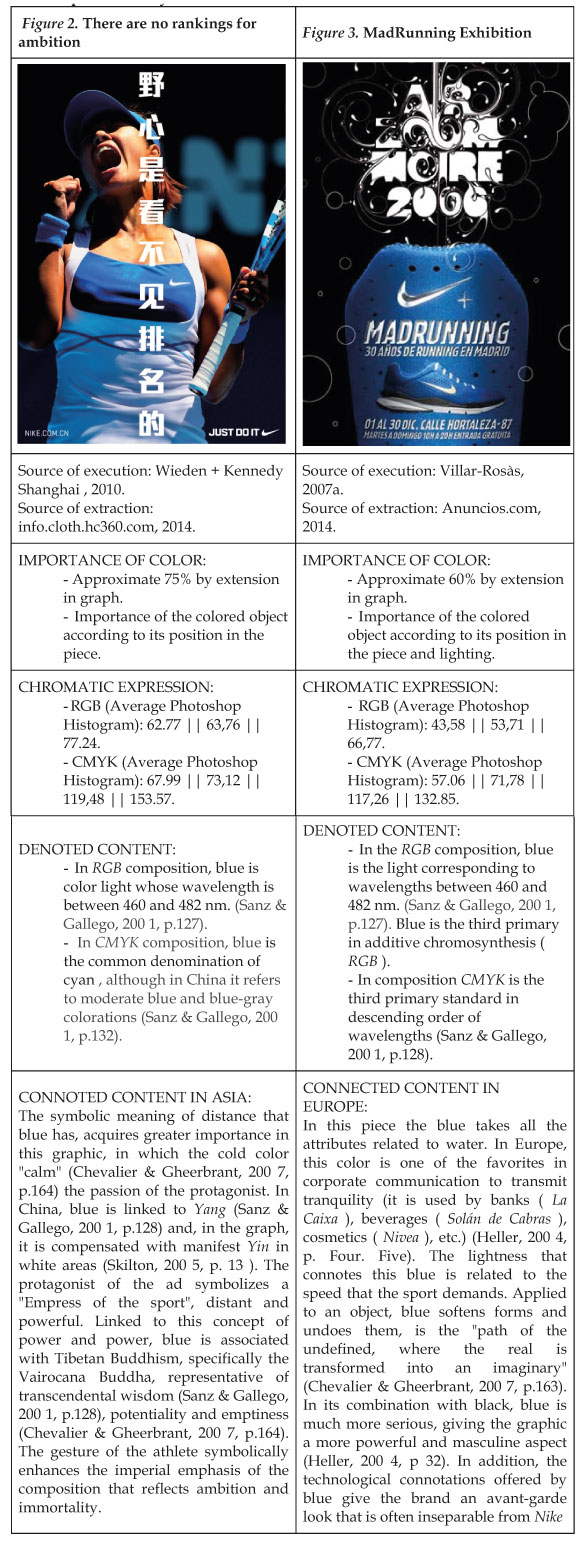
5.2. Comparative analysis of the use of red
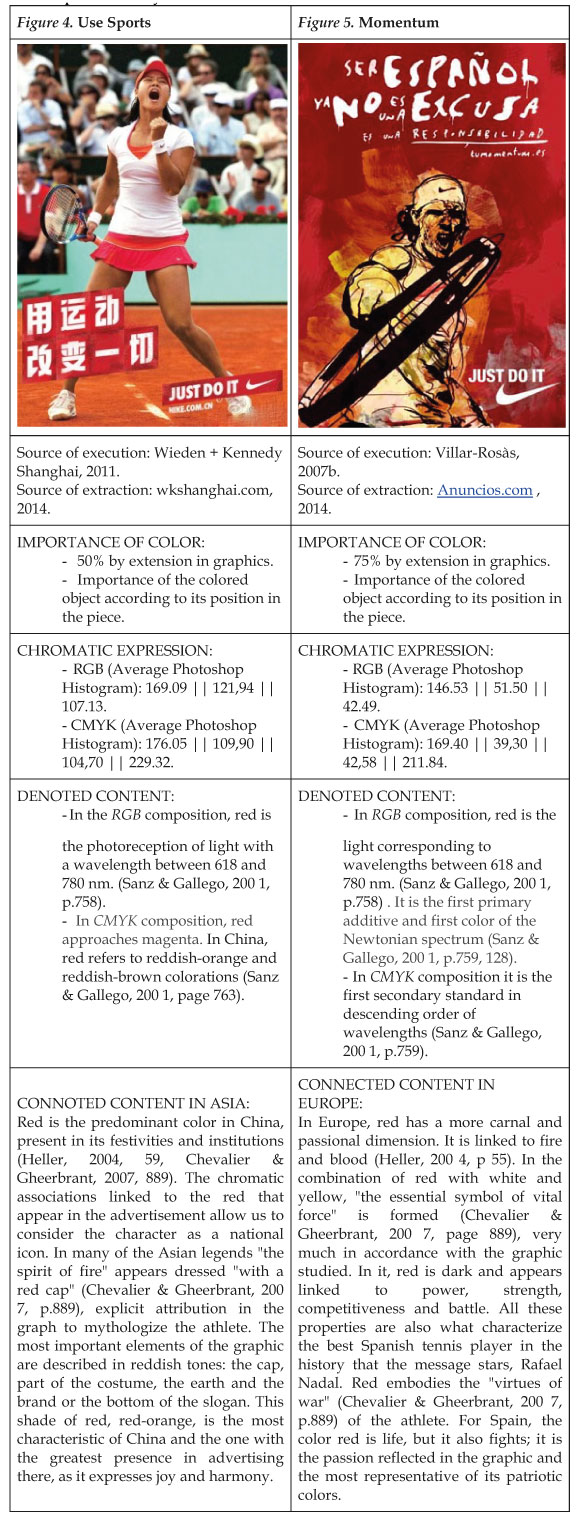
5.3. Comparative analysis of the use of yellow
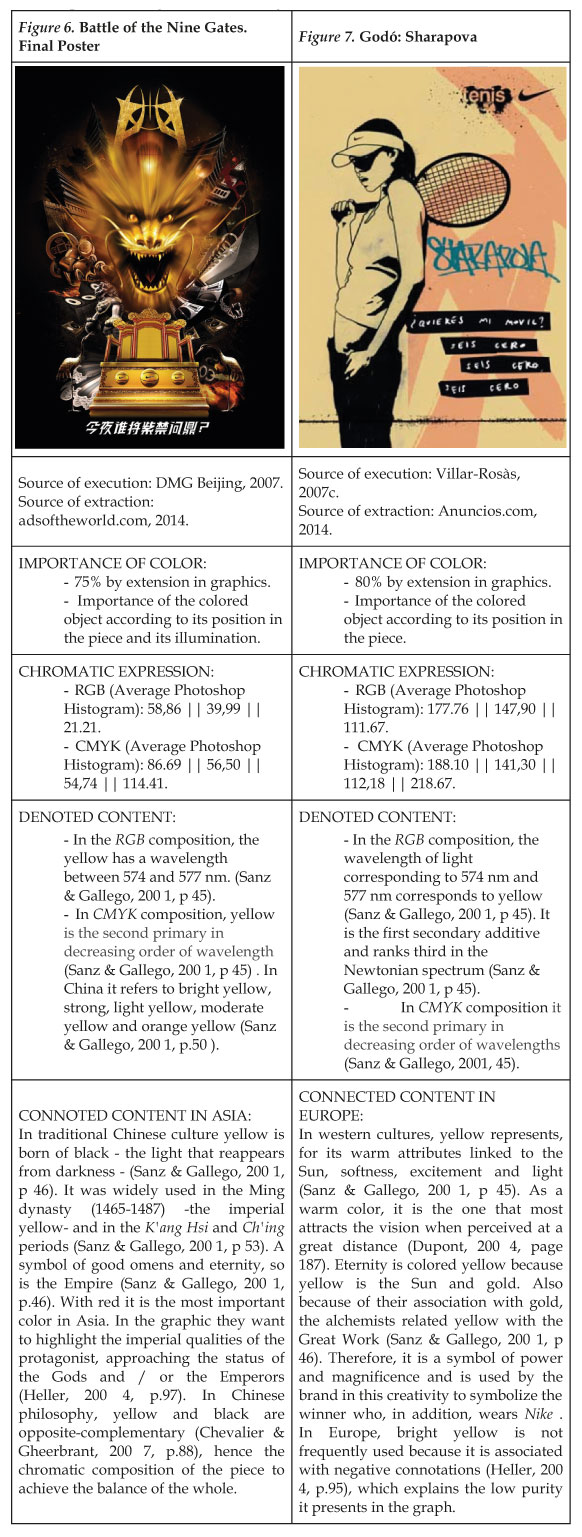
5.4. Comparative analysis of the use of green
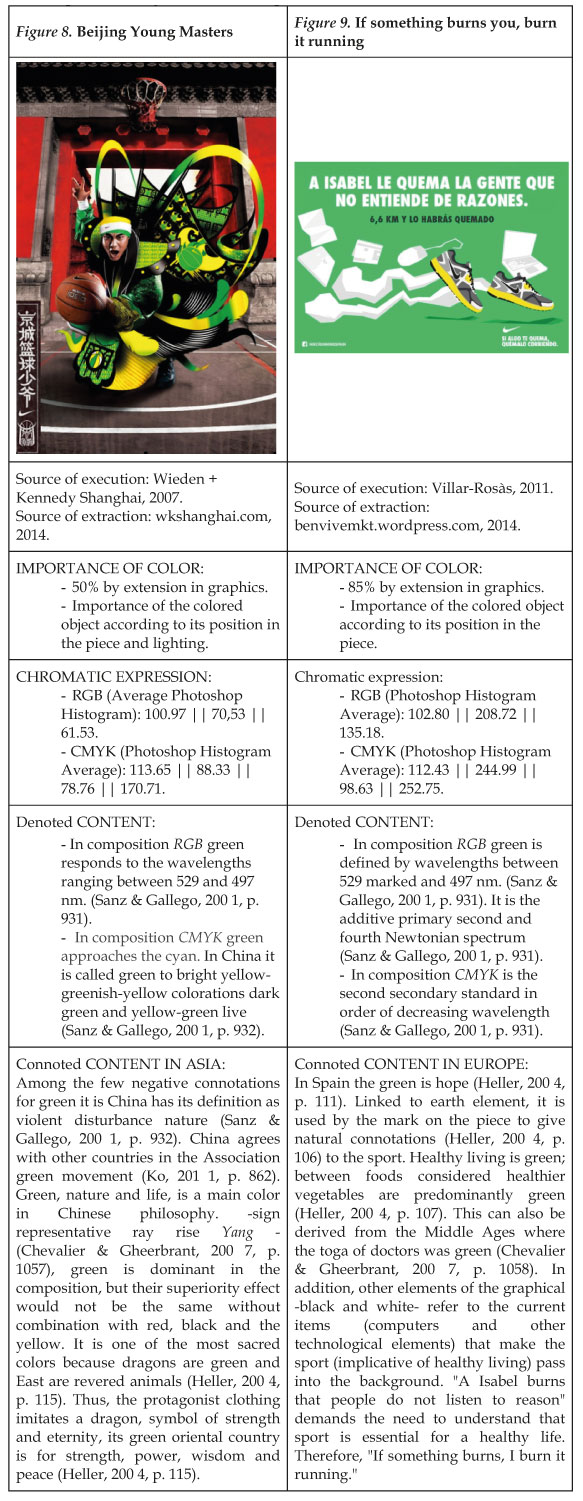
5.5. Comparative analysis of the use of white
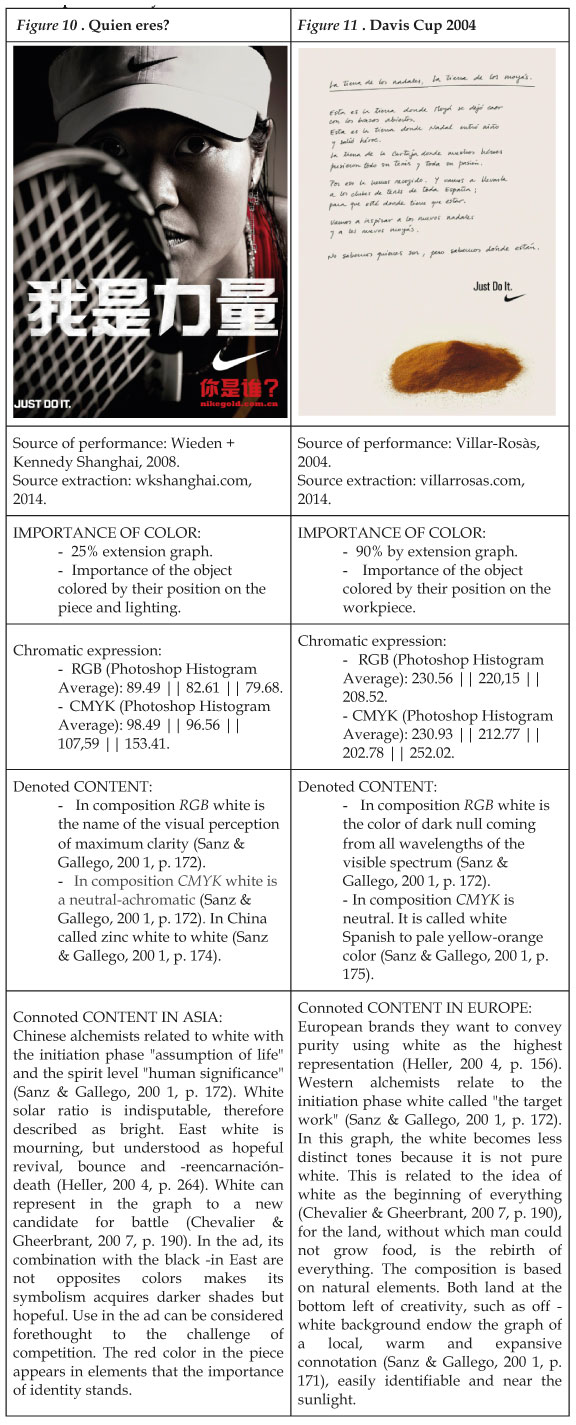
5.6. Comparative analysis of the use of black
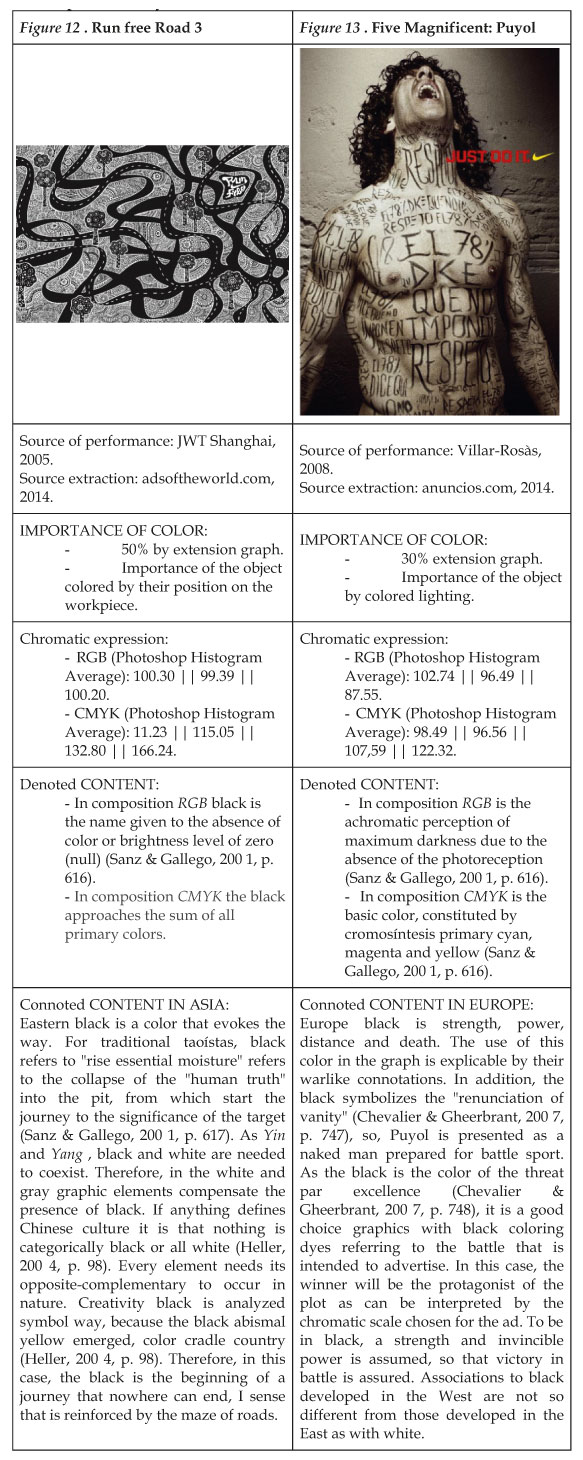
6. CONCLUSIONS AND DISCUSSION
6.1. Hypothesis contrast
The results extracted and summarized in the previous section of this proposal confirm the hypothesis stated at the start of this paper. Cultural connotations associated with certain colors influence the composition of graphic advertising. Thus it can be seen, for example, that in Asia the use of yellow is important to mystify brands and praise the characters included in them, whereas in Europe it is not frequently used with the dimensions of the Asians and “discrete yellows” are opted for.
Confirmation of this hypothesis leads to the conclusion that advertising uses colors strategically, adapting their use to their symbolism in each socio-cultural context to ensure more effective communication. Thus, Nike adapts the chromatic characteristics of its graphic campaigns depending on the peculiarities of the context in which they are launched, because, as Goethe concluded, a color cannot be extrapolated from its context (Goethe, 200 2, p. 13- 19). Thus, it should be noted that, for example, in China green is a symbol of power and a fundamental color (Chevalier & Gheerbrant, 200 7, p. 1057), while in Spain it does not have that importance and its use is essentially linked to the natural and ecological matters (Heller, 200 4, p. 106-107).
This confirmation is in addition to the contributions that analyze the psychological effects of colors and their influence on emotions, such as the contributions made by Lee and Barnes, Jr. (1990) on their perceptual differences by gender (male or female ) and race (white or black) race. Thus, this proposal is a small contribution in this effort to improve the effectiveness of advertising messages, which supports the consideration of color as a key hortatory and mnemonic resource, able to get the attention of the public and the memory of the advertising message (Labrecque Patrick and Milne, 201 3, p. 199).
6.2. Other important lessons
Comparative analysis allows us to draw other considerations of interest:
1. Colors, which are part of visual communication, constitute “a system halfway between what is scientific in information and what is artistic in expression” (Sanz, 200 3, p. 189). However, from the advertising standpoint, the expressive capabilities of color to generate a connoted meaning are the ones that interest most, as they are those that make it possible to record the brand more definitively in the mind of the recipient. In fact, color is considered a leading element in advertising transformations that occur in the current communicative paradigm (Nicolas Ojeda, 201 2, p. 308). It is an element that is part of the “DNA” of the brand and allows us to build and strengthen the brand-consumer relationship (Labrecque, Patrick and Milne, 201 ratio 3, p. 199). It is therefore necessary to continue its study associated with the advertising communication, as the effectiveness of the message depends, in part, on its proper use in the message.
2. The subjective dimension of color is the one that impinges most on the construction of meaning and makes it an instrument to effectively and adaptably communicate the message of the brands. This subjectivity complicates the study of color, as it responds to the intervention of the subject who perceives it, who is particularly affected by colors (Brusatin, 198 7, p. 100-101). Any interpretation of the subject is linked to the unconscious value of what we perceive. Therefore, the latest research on advertising focuses on understanding the workings of the mind from neuroscience, in order to develop advertising strategies that are in line with consumer needs (Muñoz Sánchez, 201 2, p. 47-48) and which increase profitability without compromising creativity (Serrano Abad & Balanzó Bono, 2011).
3. The importance of colors in China is so remarkable that philosophies such as Feng Shui or Yin and Yang have them considered for the development of decorative techniques that make it possible to achieve greater harmony between man and the environment. Also, the chromatic aspects such theories collect affect the development of graphic advertising pieces that are launched in China.
4. Goethe’s color theory has had great importance in establishing the uses of color in European graphic advertising, especially for its contributions on the connotative meanings attached to the contextualization of colors. However, over time, researchers have contemplated two possibilities in this type of analysis (Labrecque, Patrick & Milne, 201 3, p. 194; Gorn, Chattopadhyay, Yi & Dahl, 199 7, p. 1398 ):
a) The study of the effects of color that operate both at a basic and universal level (global context).
b) The study of the effects of color that operate at a specific level of each culture (local context). To which the one presented in this proposal belongs.
5. Graphic advertising pieces, such as logos, help build brands using the symbolic potential of shapes and colors. Similarly to what happens with corporate logos, graphic advertising builds the ultimate meaning of the message “by common rhythm” with these shapes and colors, the connotations of which have existed since ancient times and are the result of the socio-cultural traditions (García García, Barroso Llorente & Garcia Guardia, 2010, pp. 143-144). The construction of this meaning is supported by rhetorical techniques specifically in elocution shapes that facilitate better assimilation of visual connotations (Llorente Barroso & Garcia Garcia, 2015b, p. 304). Such formulas, in the articulation of the advertising message, are based on the use of patterns “recognized by the general public or by some ‘tribe’ in particular” (Nunez-Tired, 2011, p. 57), considering that audiences “are symbols and inhabit symbols” (Rabadan Crespo, 2016, p.39).
REFERENCES
1. Álvarez JM (2008). Feng Shui, el arte del diseño: creando armonía en el espacio y en el tiempo. Buenos Aires: Kier.
2. Álvarez JM (2007). Feng Shui: la armonía de vivir. Buenos Aires: Kier.
3. Ambrose G, Harris P (2005). Color: sensación producida por los rayos luminosos que impresionan los órganos visuales y que depende de la longitud de onda. Barcelona: Parramón Ediciones.
4. Ambrose G, Harris P (2006). Imagen. Barcelona: Parramón Ediciones.
5. Baker C (2009). Chinese wedding dress. Bellaonline, the Voice of Women. http://www.bellaonline.com/articles/art32857.asp.
6. Berlin B, Kay P (1991). Basic color terms: their universality and evolution. California, Berkeley: University of California Press.
7. Block L, Kramer T (2009). The effect of superstitious beliefs on performance expectations. Journal of the Academy of Marketing Science 37:161-196. doi: 10.1007/s11747-008-0116-y.
8. Brusatin M (1987). Historia de los colores. Barcelona: Paidós Estética.
9. Caivano JL (1995). Sistemas de orden del color. Buenos Aires: Universidad de Buenos Aires.
10. Carreres-Ribera RA (2011). El color y su percepción. Publicaciones Didácticas 18:19-23. http://www.seindor.com/publicacionesdidacticas.com/hemeroteca/pd_018_oct.pdf.
11. Chevalier J, Gheerbrant A (2007). Diccionario de los símbolos. Barcelona: Herder.
12. D’Andrade R, Egan M (1974). The color of emotion. American Ethnologist 1:49-63. doi: 10.1525/ae.1974.1.1.02a00030.
13. Dupont L (2004). 1001 Trucos Publicitarios. Barcelona: Robinbook.
14. Chen F (2008). Vacío y plenitud. Madrid: Siruela.
15. Drew JT, Meyer SA (2008). Guía para diseñadores gráficos: tratamiento del color. Barcelona: Blume.
16. Edwards B (2006). El color: un método para dominar el arte de los colores. Barcelona: Urbano.
17. Ferrer E (1999). Los lenguajes del color. México: Fondo de Cultura Económica.
18. Fraser T, Banks A (2004). Designer’s color manual: the complete guide to color theory and application. San Francisco (CA): Chronicle Books.
19. Gatter M (2005). Listo para imprenta: cómo llevar los proyectos de la pantalla al papel. Barcelona: Index Book.
20. García-García F, Llorente-Barroso C, García-Guardia ML (2010). La construcción globalizada del logo-símbolo y la globalización de la marca a través del mismo. Historia y Comunicación Social 15:125-148. http://revistas.ucm.es/index.php/HICS/article/view/HICS1010110125A/18717.
21. Goethe JW (von) (1922). Teoría de los colores. Valencia: Artes gráficas Soles.
22. Goethe JW (von) (2002). Goethe y la ciencia. Madrid: Siruela.
23. Goldman R, Papson S (1998). Nike culture: the sign of the swoosh. Thousand Oaks (CA): Sage.
24. Gorn GJ, Chattopadhyay A, Yi T, Dahl DW (1997). Effects of color as an executional cue in advertising: they’re in the shade. Management Science 43(10):1387-1400. doi:10.1287/mnsc.43.10.1387.
25. Heller E (2004). Psicología del color: cómo actúan los colores sobre los sentimientos y la razón. Barcelona: Gustavo Gili.
26. Ko YH (2011). Influencing factors on color and product-function association. Psychological Reports 108(3):861-873. doi 10.2466/01.09.24.PR0.108.3.861-873.
27. Kreitler H, Kreitler S (1972). Psychology of the arts. Durham (NC): Duke University Press.
28. Küppers H (1982). Fundamentos de la teoría de los colores. Barcelona: Gustavo Gili.
29. Labrecque LI, Patrick VM, Milne GR (2013). The marketers’ prismatic palette: a review of color research and future directions. Psychology and Marketing 30(2):187-202. doi: 10.1002/mar.20597.
30. Lee S, Barnes-Jr JH (1990). Using color preferences in magazine advertising. Journal of Advertising Research 29(6):25-30.
31. Llorente-Barroso C, García-García F (2015a). La construcción retórica del swoosh de Nike: el discurso comercial de la victoria. Prisma Social 14:470-513. http://www.isdfundacion.org/publicaciones/revista/numeros/14/secciones/abierta/a_03_discurso_comercial.html.
32. Llorente-Barroso C, García-García F (2015b). The rhetorical construction of corporate logos. Arte, Individuo y Sociedad 27(2):289-309. doi: 10.5209/rev_ARIS.2015.v27.n2.44667.
33. Madden N (2010). China’s success in Melbourne is also a win for Nike and Anta. http://adage.com/china/article/china-news/chinas-success-in-melbourne-is-also-a-win-for-Nike-and-anta/141888/
34. Madden TJ, Hewett K, Roth MS (2000). Managing images in different cultures: a cross-national study of color meanings and preferences. Journal of International Marketing 8(4):90-107.
35. Muñoz-Sánchez O (2012). La emoción y la razón en la estructura de pensamiento estratégico publicitario. Una visión de la marca desde la psicología cognitiva y la neurociencia. Trípodos 29:39-51. http://www.tripodos.com/index.php/Facultat_Comunicacio_Blanquerna/issue/view/1/showToc.
36. Nicolás-Ojeda MÁ (2012). La implicación del usuario en la producción publicitaria: una reflexión sobre la publicidad espontánea generada por los usuarios/consumidores. Icono 14 11(1):303-317. doi: 10.7195/ri14.v11i1.204.
37. Núñez-Cansado M (2011). Ingeniería de la metonimia en la publicidad gráfica. Vivat Academia XIII(116):52-74. doi: 10.15178/va.2011.116.52-74.
38. Rabadán-Crespo AV (2016). Selfie y la impronta visual: el autorretrato 3.0 representación, presentación, corporealización. Icono 14 14(2):25-47. doi: 10.7195/ri14.v24i2.952.
39. Sanz JC (2003). El libro del color. Madrid: Alianza Editorial.
40. Sanz JC, Gallego R (2001). Diccionario del color. Madrid: Akal.
41. Serrano-Abad N, Balanzó-Bono C (de) (2011). Neurociencias y estrategia publicitaria: redefiniendo el rol del inconsciente. Trípodos 28:35-50. http://www.raco.cat/index.php/Tripodos/article/view/247474/331380.
42. Skilton P (2005). Feng Shui - Hemisferio Sur. Buenos Aires: Albatros Saci.
43. Spar DL (2003). Managing International Trade and Investment. London: Imperial College Press.
44. Wong W (1995). Fundamentos del diseño. Barcelona: Gustavo Gili.
45. Wong W (2008). Principios del diseño en color. Barcelona: Gustavo Gili.
46. Zelansky P, Fisher MP (2001). Color. Madrid: Blume.
47. DMG Beijing (2007). Battle of the Nine Gates. Final Poster. http://adsoftheworld.com/media/print/Nike_battle_of_the_nine_gates_final_poster.
48. JWT Shanghai (2005). Run free road 3. http://adsoftheworld.com/media/print/Nike_road_3.
49. Villar-Rosàs (2008). 5 Magníficos: Puyol. http://www.anuncios.com/grafica/nuevos-anuncios/1027786012301/Nike.1.html.
50. Villar-Rosàs (2004). Davis Cup 2004. http://www.villarrosas.com/campaigns/davis-cup-2004/
51. Villar-Rosàs (2007c). Godó: Sharapova. http://www.anuncios.com/grafica/nuevos-anuncios/1010755012301/Nike.1.html.
52. Villar-Rosàs (2007a). Exposición MadRunning. http://www.anuncios.com/grafica/nuevos-anuncios/1015739012301/Nike.1.html.
53. Villar-Rosàs (2007b). Momentum. http://www.anuncios.com/VerPiezas/grafica/nuevos-anuncios/1021616012301/Nike.1.html.
54. Villar-Rosàs (2011). Si algo te quema, quémalo corriendo. http://benvivemkt.wordpress.com/2012/01/10/Nike-motiva-a-los-jovenes-a-correr-si-algo-te-quema-quemalo-corriendo/
55. Wieden+Kennedy Shanghai (2007). Beijing Young Masters. http://wkshanghai.com/#work/p_425_client.
56. Wieden+Kennedy Shanghai (2010). There are no Rankings for Ambition. http://info.cloth.hc360.com/2010/02/021130165915.shtml.
57. Wieden+Kennedy Shanghai (2011). Use Sports. http://www.wkshanghai.com/#work/p_2778_client.
58. Wieden+Kennedy Shanghai (2008). Who are you? http://wkshanghai.com/#work/p_6_client.